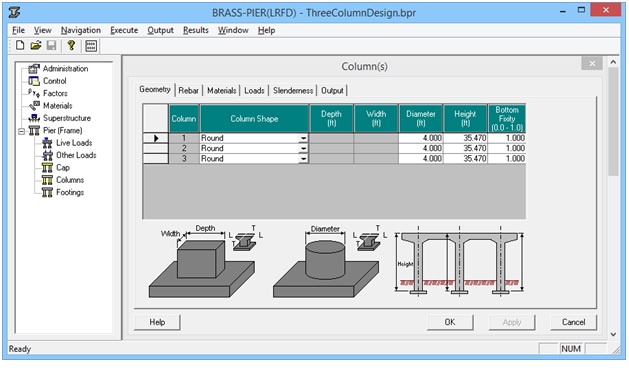- Home
- Administration
- Aeronautics
- Business with WYDOT
- Construction Projects
- Driver License and Records
- Economic Stimulus Projects (ARRA - TIGER)
- Engineering and Technical Programs
- Fuel Tax
- Highway Safety
- Human Resources
- Manuals and Publications
- News and Information
- Permits
- Planning/Projects/Research
- Titles, Plates and Registration
- Travel
- Trucking / Commercial Vehicles
- Vehicle Business Regulation
- Wyoming Highway Patrol
- Search
- Sitemap
BRASS-PIER(LRFD)
BRASS-PIER(LRFD)™– Version 2.7 – November 2021
This program is current with the AASHTO LRFD Bridge Design Specifications, 9th Edition, 2020. The US units version of the specifications is incorporated in this program.
BRASS-PIER(LRFD)™ is a computer program developed to assist in the analysis and design of reinforced concrete piers for bridges. The system analyzes a transverse (normal to the centerline of the roadway) cross-section of a bridge.
BRASS-PIER(LRFD)™ presently consists of the following components:
- Deck Analysis and Loading
- Pier Cap Analysis and Design
- Pier Analysis and Loading
- Ultimate Strength Design/Analysis of Concrete Column Sections (PCA Column Design)
- Pier Support (Footing) Analysis and Design
Deck Analysis and Loading
The Deck Analysis and Loading Component will apply dead and live loads to a bridge deck section (one-foot-wide transverse strip) and distribute the loads as reactions to the girders.
The reactions output from the Deck Analysis and Loading Component may be used as uniform load per foot for longitudinal girder analysis. The longitudinal girder reactions at the pier are then used by the Pier Analysis and Loading Component. An understanding of how BRASS PIER(LRFD)™ and a longitudinal girder analysis system such as BRASS GIRDER(LRFD)™ work together to determine loads to the pier is paramount to utilizing BRASS PIER(LRFD)™ to its fullest extent.
The Deck Analysis and Loading Component can analyze bridge decks supported on two or more girders, up to a maximum of twenty. The Deck Loading Component has three purposes. The first is to assist the engineer in the analysis of the deck itself. See BRASS GIRDER(LRFD)™ for complete information. The second is to assist in the analysis of the longitudinal girder system with the distribution of the dead load of the deck to the girders. The third is to assist in the analysis of a frame pier with the distribution of live load to the girder bearings and hence to the pier.
The dead load distribution section of the Deck Analysis and Loading Component will calculate and apply dead loads to the deck using the dimensions of the deck, curbs, etc., and any superimposed loads input.
Pier Cap Analysis and Design
The pier cap analysis component will either review flexure and shear reinforcement as specified by the user or compute the required reinforcement for flexural and shear. The review/design can be performed for both solid shaft and frame piers. The cap analysis component cap be run either as part of a full pier analysis or independently.
Pier Analysis and Loading
The Pier Analysis and Loading Component, using the dimensions and loads input, will apply the resulting forces to the pier and determine the resultant actions in the pier (shear and moment in the cross beam, axial load and moment in the columns). The PCA Column Design Component, when supplied the cross section properties and applied loads, will determine the required column reinforcement. If the actual column reinforcement is input, the program will determine the adequacy of the section to resist the applied loads. The Pier Support Component takes the forces at the bottom of the columns and performs one or more types of footing design.
The Pier Analysis and Loading Component will analyze either solid shaft piers or frame piers with two to six columns. The loads which may be applied are: Dead, Live, Wind, Shrinkage, Temperature, Centrifugal Force, Longitudinal Force, Earthquake, Buoyancy, Stream Flow, and Ice Pressure. The vertical loads from the superstructure (Dead and Live load) may be applied by either input of the girder reactions or automatically through the Deck Analysis and Loading Component. The horizontal forces from the superstructure (Centrifugal and Longitudinal, or Braking, forces) and the forces from nature (Buoyancy, Stream Flow, and Ice Pressure) may be applied by either input of the force or by input of the data required to calculate the force. Forces applied transversely to the superstructure are applied longitudinally to the substructure. Conversely, load applied longitudinally to the superstructure are applied transversely to the substructure. The forces on the pier which result from the application of the various loads are combined according to the AASHTO specifications for Combination of Loads, 3.4.1.
Column
The Column Analysis Component will analyze columns from either solid shaft piers or frame piers. This component may be run independently or be included in a complete pier analysis wherein the loads will be passed automatically to this component.
As there is a very large number of load cases to consider for the design of columns in a frame pier, it is impractical to analyze each case. The many possible positions of trucks on the bridge deck and number of group load combinations create literally thousands (depending on deck width) of load cases of ML, MT, and P. BRASS PIER(LRFD)™ automatically eliminates all identical load cases, and then utilizes the following procedure to reduce the number of load cases to a maximum of 50.
Footing
The Footing Analysis Component consists of the following sections:
- Spread Footing analysis
- Footing on Piles analysis
This component may be run independently or be included in a complete pier analysis wherein the loads will be passed automatically to this component.
System Requirements
Operating System Microsoft Windows™ 7, 8, 8.1 or 10
Microprocessor Pentium IV or higher
Microsoft .NET Framework 4.7.2
Memory 16 MB required, more is better
Hard Disk Space Approximately 25 MB
Disk Drive DVD drive







